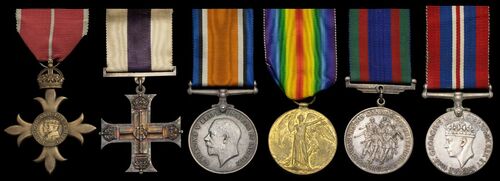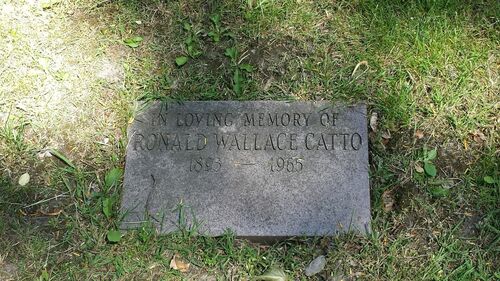Auction: 24112 - Orders, Decorations and Medals - e-Auction
Lot: 671
(x) A very fine 1945 O.B.E., Hill 70 M.C. group of six awarded to Lieutenant-Colonel R. W. Catto, Veterans Guard of Canada, who took his first decoration as a Captain with the 19th (Central Ontario) Battalion, Canadian Expeditionary Force during the Great War
The Most Excellent Order of the British Empire, 2nd Type, Military Division Officer's (O.B.E.) breast Badge, silver-gilt, in its case of issue; Military Cross, G.V.R., unnamed as issued; British War and Victory Medals (Capt. R. W. Catto.); Canada Service and War Medals 1939-45, these last two Canadian issues in silver, good very fine (6)
O.B.E. London Gazette 1 January 1946 (Veterans Guard of Canada).
M.C. London Gazette 7 March 1918:
'For conspicuous gallantry and devotion to duty in commanding his company during an attack. He led them with great dash and personal gallantry, capturing seventy prisoners and inflicting severe losses on the enemy. After consolidating he beat off three determined hostile -counter-attacks, in which more prisoners were taken and many of the enemy were killed. His coolness and sound judgment under trying conditions and his energetic initiative contributed much to the success of the operations. His example was a splendid inspiration to his men.'
Biographical Dictionary of Architects in Canada offers good detail:
'Ronald Wallace Catto of Toronto was born there on 9 June 1893 and attended the Univeristy of Toronto from 1911-15 while working part-time in the offices of J.M. Lyle, Wickson & Gregg, and Darling & Pearson. He graduated with honours from the Dept. of Architecture in 1915 and then went overseas to serve with the Royal Flying Corps during WWI. He moved to Detroit, Mich. in 1919 where he formed a partnership with J. Will Wilson as Wilson & Catto, Architects & Engineers (active Detroit 1919-22). Catto returned to his home town in 1922 and opened an office under his own name, assisted by his younger brother Douglas E. Catto. In 1925 the brothers formed a new partnership of Catto & Catto and specialised in residential and commercial design. R.W. Catto was an articulate advocate of apartment house construction in the 1920's when the public perception of this new building type was obscured by examples of tenement house construction in other cities. His lengthy essay in support of courtyard apartment prototypes appeared in the Toronto Star Weekly, 27 February 1926. He also demonstrated a keen interest in retail shop design and wrote extensively on the subject in 1933 (R.A.I.C. Journal, x, Nov. 1933, 178-85, illus.). He was among a dozen architects invited to make a radio broadcast on contemporary architecture in 1935 and presented his views on commercial building aesthetics (R.A.I.C. Journal, xii, Feb. 1935, 33). After the dissolution of their partnership in 1939 R.W. Catto served with the Canadian Infantry during WWII and retired from practise after 1950. He died at Bracebridge, Ont. on 27 December 1965.'
Of his service during the Great War, Catto was commissioned into the Royal Flying Corps in August 1915 but was then moved to the General List, being attached to the Canadian Army Service Crops in January 1916. He went to France with the 19th (Central Ontario) Battalion later that year and was promoted Captain in April 1917, also gaining a 'mention' (London Gazette 18 October 1917, refers). He shared in the actions at Amiens, Somme, Vimy Ridge and Paschendaele, being awarded his M.C. for fine services at Hill 70 in August 1917. Having returned to the fold with the Veterans Guard of Canada during the Second World War, taking the O.B.E. for his work, he was buried in the Toronto Necropolis Cemetery and Crematorium; sold together with his Front Line Service Badge, numbered '278695' and General Service Badge.
Subject to 5% tax on Hammer Price in addition to 20% VAT on Buyer’s Premium.
Sold for
£2,000
Starting price
£950







